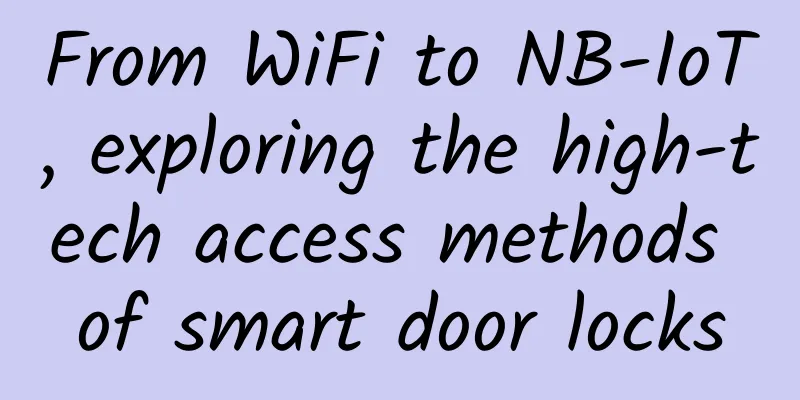From WiFi to NB-IoT, exploring the high-tech access methods of smart door locks

|
Hello everyone! I am Xiaomi, a 29-year-old who is full of energy and loves to share technology! Today, I would like to talk to you about a technical topic closely related to smart home - the access method of smart door locks. Whether it is home, office building or hotel, the application of smart door locks in the field of Internet of Things is becoming more and more extensive. Different door lock access methods bring different experiences and technical implementation methods. Today we will talk about four mainstream smart door lock access methods: WIFI door lock, Bluetooth door lock, Zigbee door lock and NB-IoT door lock. WIFI door lock: non-keep-alive, MCU wake-up mechanismFirst, let’s take a look at the WIFI door lock. 1.1 What is a WIFI door lock?WIFI door lock, as the name implies, is a smart door lock connected via a Wi-Fi network. Through the WIFI door lock, users can remotely view the door lock status, unlock the door, and even receive alarm information from the door lock. However, a major feature of the WIFI door lock is that it is usually in a non-keep-alive state. 1.2 Definition of non-keepaliveThe "non-keep-alive" state means that the WIFI door lock is not online in real time. Most of the time, the main control unit (MCU) and Wi-Fi module of the door lock are in sleep mode to save power. After all, the working mode of the Wi-Fi door lock consumes more power, especially for battery-powered door locks. Long-term keep-alive will cause rapid battery consumption and affect the user experience. 1.3 Wake-up mechanismWhen data needs to be transmitted or sent, the MCU must be used to wake up the door lock's WiFi module. Common wake-up mechanisms may include the following:
1.4 Application ScenariosWIFI door locks are suitable for places with stable network and sufficient power supply, such as some high-end residences or smart buildings. Their WIFI coverage is relatively comprehensive, and users can remotely control them through mobile phone APP or other devices anytime and anywhere. Bluetooth door lock: short-range single point and long-range gateway accessNext, let's talk about Bluetooth door locks. This type of door lock is also very common in smart homes, especially suitable for scenarios that require low power consumption and convenient connection. 2.1 Bluetooth door lock docking methodThere are two common access methods for the working mode of Bluetooth door locks:
2.2 Proximity Single Sign-OnThe main advantages of Bluetooth door locks are their low power consumption and stability, especially when single-point login is performed at close range. Users can pair the door lock directly with Bluetooth through their mobile phones and send unlocking instructions through the APP within a few meters. This process does not rely on the network and is not affected by network fluctuations, so it is very suitable for temporary visitors and family members. 2.3 Remote Gateway LoginIn order to break through the limitation that Bluetooth door locks can only be used at close range, many manufacturers also provide Bluetooth gateways. The Bluetooth gateway can act as an intermediate bridge to convert the Bluetooth signal of the door lock into Wi-Fi or other network signals. Even if the user is not at home, he can remotely control the door lock through the cloud. The login and data transmission in this process are completed by the gateway, making remote control possible. 2.4 Application ScenariosBluetooth door locks are suitable for home users, short-term rental apartments and other scenarios, especially in close-range use scenarios, where Bluetooth door locks perform particularly well. In addition, the remote control capability with Bluetooth gateway allows users to enjoy convenient remote control even if they are not near the door lock. Zigbee door lock: low power consumption, heartbeat mechanismThe third common access method is Zigbee door lock. Zigbee is a low-power, low-latency wireless communication protocol that is widely used in IoT devices, especially in smart home scenarios. 3.1 Non-keep-alive but heartbeatZigbee door locks are in a non-keep-alive state, just like WIFI door locks, but they have an additional advantage: they keep heartbeats. The heartbeat mechanism means that when the device is in sleep mode, it will still periodically send a short signal to the gateway or control center to inform it of its current status (for example, whether it is online, whether there is a fault, etc.). This heartbeat mechanism can not only effectively save power, but also ensure that the online status of the device is updated in real time, making it easier for the background system or users to understand the device status. 3.2 MCU docking and Zigbee protocol controlZigbee door locks are usually connected through MCU, which controls the Zigbee module to communicate. The Zigbee protocol provides standardized control and management functions, which can support the automatic control and networking functions of the device, such as:
3.3 Application ScenariosZigbee door locks are very suitable for smart home systems, especially in scenarios where multiple devices need to be linked to each other. For example, when a sensor detects an abnormality, it can automatically trigger the lock or unlock function of the door lock. This interconnection gives Zigbee door locks an irreplaceable advantage in complex smart home scenarios. NB-IoT door lock: based on public network, SAAS serviceFinally, let's take a look at NB-IoT door locks. NB-IoT (Narrowband Internet of Things) is an IoT technology based on cellular networks, with the characteristics of wide coverage, low power consumption and large connections. The biggest feature of NB-IoT door locks is that they can be connected to the public network for remote control and management. 4.1 Public network connection, flexible deploymentNB-IoT door locks do not need to rely on short-distance connection methods such as local area networks or Bluetooth, but directly use cellular networks to connect to cloud servers. Through public network connection, door locks can not only be deployed anywhere with signals, but also achieve real-time remote control and monitoring. 4.2 Turning access control into a SAAS serviceThanks to NB-IoT technology, door lock devices can be easily connected to the cloud to realize SAAS services of the devices. For example, property management companies can manage the smart access control system of the entire community or building through a unified platform, and users can remotely unlock the door, view logs, and other operations through mobile phone applications. 4.3 MCU Control and NB-IoT CommunicationThe hardware design of NB-IoT door locks is usually controlled by MCU and data communication is carried out through NB-IoT modules. Due to the extremely low power consumption of NB-IoT, door lock devices can remain online for a long time and continue to send and receive data without the need for frequent charging or battery replacement. 4.4 Application ScenariosNB-IoT door locks are particularly suitable for large-scale access control management scenarios, such as residential areas, office buildings, hotels, etc. Through NB-IoT connection, property companies can easily implement cross-regional access control management without the need to deploy gateway devices for each door lock, greatly reducing operating costs. ENDThrough the above introduction, we have learned about four common smart door lock access methods: WIFI door lock, Bluetooth door lock, Zigbee door lock and NB-IoT door lock. Each door lock access method has its unique advantages and application scenarios:
Each door lock has its best application scenario, and developers can choose the appropriate access method according to actual needs. In the future, with the continuous development of Internet of Things technology, the access methods of smart door locks will be richer and more intelligent, bringing more convenience and security to our lives. |
Recommend
The difference between hybrid WAN and SD-WAN
The concepts of hybrid WAN and SD-WAN are often m...
The Ministry of Industry and Information Technology reminds you to set the SIM card password in time. Doing these four things after losing your phone is more important than calling the police.
[[347353]] If you lose your phone, do you know wh...
Just remember one number and you can quickly calculate the available range of the IP segment.
As long as you remember a simple number, you can ...
iWebFusion: $9.38/month KVM-4GB/30GB/2TB/5 data centers including Los Angeles
iWebFusion is a site under the old foreign host c...
Can Huawei reshape the Internet?
[[320457]] This article is reproduced from Leipho...
2G and 3G withdraw from the Internet of Things! The Ministry of Industry and Information Technology issued a major document
On May 7, the Ministry of Industry and Informatio...
Advantages and Challenges of 5G Network Slicing
The fifth generation of mobile communication syst...
Advantages of 5G networks and the main problems they face
5G networks are the next generation of wireless t...
How IPv6 works in the Internet
[[342618]] This article is reprinted from the WeC...
Ruijie Cloud Desktop is deployed in Tianjin Pharmaceutical Research Institute to help build a model for digital transformation of pharmaceutical companies
With the advancement of the "Healthy China 2...
You want to ask me about the application layer? I'll just talk to you about it.
Network applications are the reason for the exist...
Rethinking the future of 5G through the lens of extended reality (XR)
5G technology is developing globally, and Singapo...
Network Programming - Another Look at TCP's Four Waves
[[270759]] Preface Four waves The four-wave proce...
ZJI newly launched Hong Kong one machine three lines (Kwai Wan/Alibaba Cloud/Huawei Cloud) server, 20% off monthly payment starting from 800 yuan
ZJI is a well-known hosting company in the WordPr...









